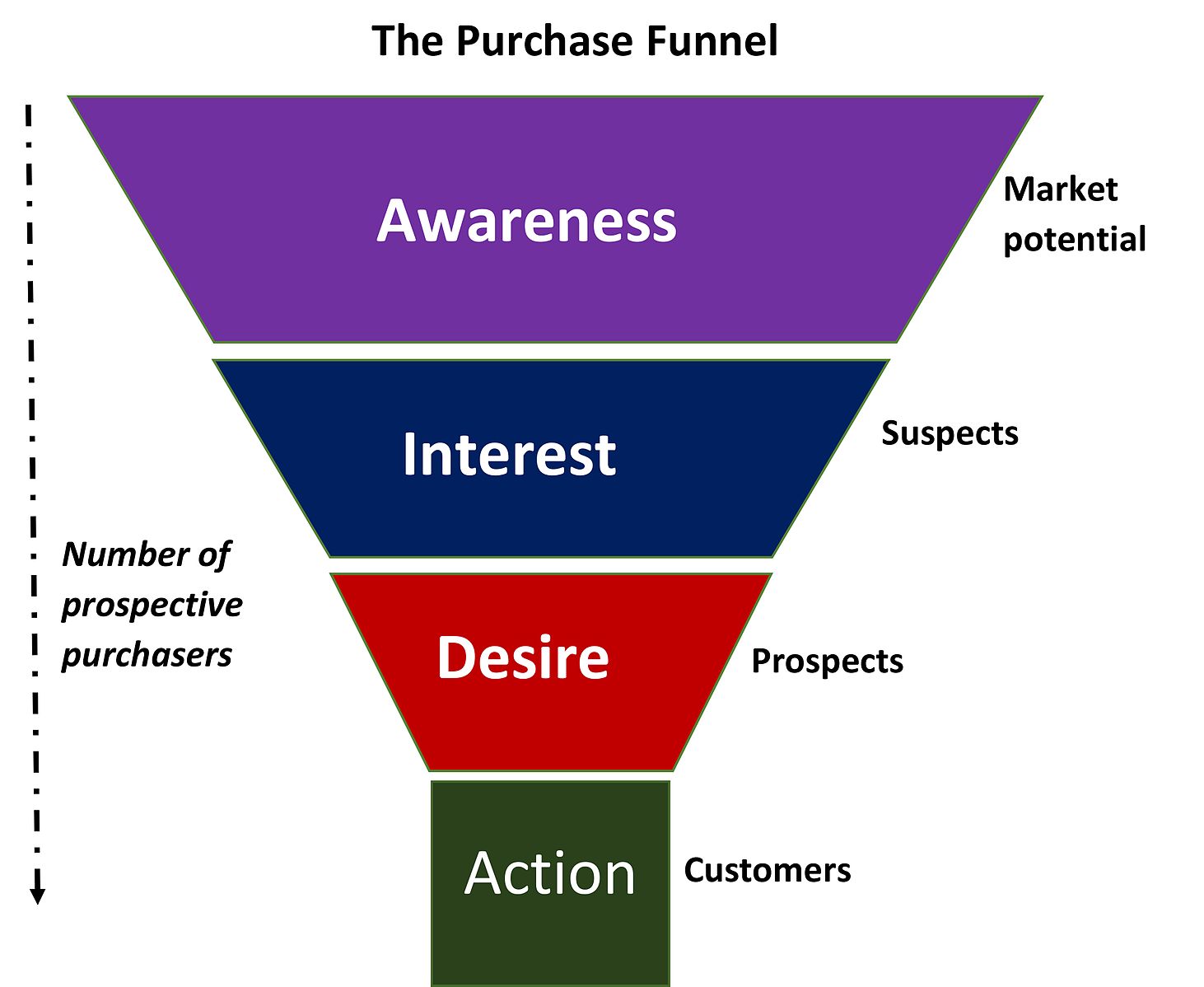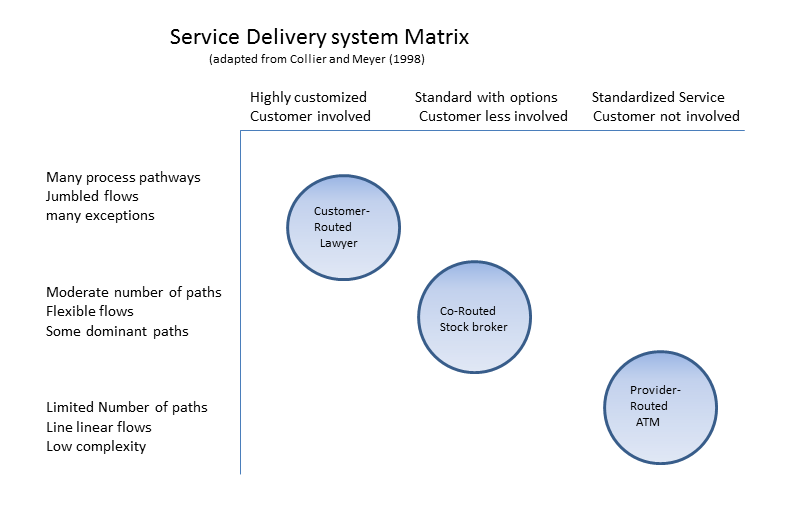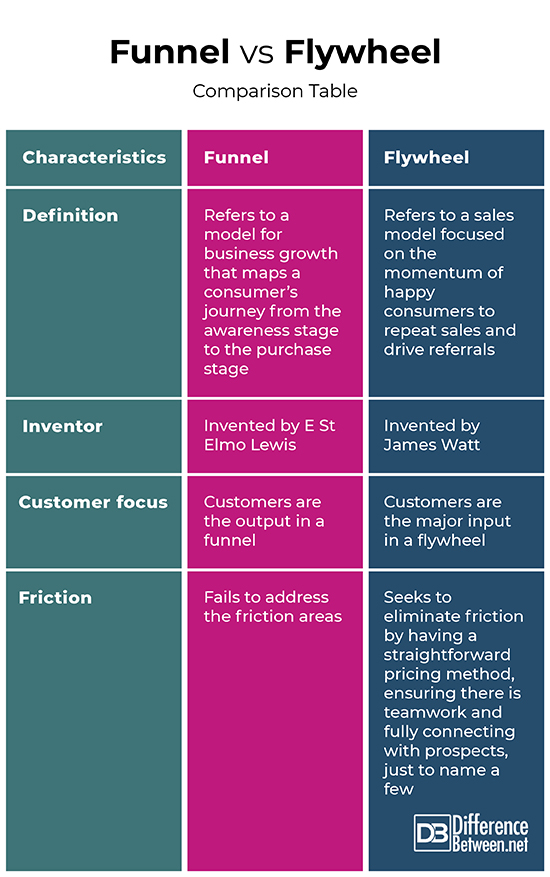Difference Between Funnel and Flywheel
From funnel to flywheel! You have probably come between these two terms in the business world, specifically sales and marketing. For a long period, companies have structured their sales and marketing activities around the sales funnel. While this has been proven to be effective, it has had some fails on the salespeople, business leaders and marketers. Seeing that word-of-mouth and customer referrals are one of the largest influence on consumer behavior, the sales funnel is flawed in that it views the consumer as an afterthought as opposed to a driving force. This led to the flywheel, described below.

What is a Funnel?
Invented by E St Elmo Lewis, this is a model for business growth that maps a consumer’s journey from the awareness stage to the purchase stage. Depending on the buying persona, types of products and services, the journey might differ.
Stages in the sales funnel include;
- Awareness- This is the initial stage in the sales funnel where a prospect consumer learns about an existing product or service. It can be through Google ads, social media posts, billboards and radio advertisements, just to name a few.
- Interest- Here, the consumer shows interest in the product or service. This can be shown by activities such as enquiring about a product, a like on a social media post, following a business online, actively searching for the product’s site and subscribing to the mail list.
- Evaluation- Here, the consumer will compare similar product or services between different providers.
- Decision- A final decision is then made, followed by negotiations.
- Action- The consumer purchases the product.
- Customer retention- To ensure return customers and referrals, after-sale incentives including special offers, technical assistance guidelines and product usage guides should be offered.
Over time, the sales funnel has been flowed, because it does not prioritize on the customer. It often leads to the mindset of job completion once a prospect has converted.

What is a Flywheel?
Invented by James watt, this is a sales model focused on the momentum of happy consumers to repeat sales and drive referrals. It is a model that functions on the premise of customer satisfaction through spending all the energy on the consumer, hence positively translation on not only sales but also other aspects of the business including scalability and revenue growth.
In the flywheel, the consumer is centered, with the amount of momentum or energy-dependent on;
- The level of friction
- How fast the flywheel spins
- Elimination of friction between teams
For instance, customers may be at the center of sales, marketing and services. The speed of the flywheel increases with an increase in large impacting areas, such as customer service.
Friction, which leads to inefficiencies, should also be eliminated from the business strategy. This can be done by having a straightforward pricing method, ensuring there is teamwork and fully connecting with prospects, just to name a few.
It is, however, important to note that different business settings will have a varying flywheel.
Similarities between funnel and flywheel
- Both aim at converting prospects into sales
Differences between funnel and flywheel
Definition
A funnel refers to a model for business growth that maps a consumer’s journey from the awareness stage to the purchase stage. On the other hand, a flywheel refers to a sales model focused on the momentum of happy consumers to repeat sales and drive referrals.
Inventor
While the funnel was invented by E St Elmo Lewis, the flywheel was invented by James Watt.
Customer focus
The customers are the output in a funnel. On the other hand, the customers are the major input in a flywheel.
Friction
While the funnel fails to address the friction areas, the flywheel seeks to eliminate friction by having a straightforward pricing method, ensuring there is teamwork and fully connecting with prospects, just to name a few.
Funnel vs. Flywheel: Comparison Table

Summary of Funnel vs. Flywheel
A funnel refers to a model for business growth that maps a consumer’s journey from the awareness stage to the purchase stage. On the other hand, a flywheel refers to a sales model focused on the momentum of happy consumers to repeat sales and drive referrals.
Although they both aim at converting prospects into sales, the flywheel is more effective as it centers the customers in its processes and also seeks to eliminate friction by having a straightforward pricing method, ensuring there is teamwork and fully connecting with prospects. What may work for one business model can fail for the other, as business needs differ.
- Difference Between Profit Center and Investment Center - July 2, 2022
- Difference Between Anti-Trust and Anti-Competition - June 6, 2022
- Difference Between Stocktaking and Stock Control - June 6, 2022
Search DifferenceBetween.net :
Leave a Response
References :
[0]Ritesh Chaube. Visionary Marketing: The Seminal Playbook for Building Winning Businesses. stanfis llc dba 200k mba publishers. https://books.google.co.ke/books?id=fBuWDwAAQBAJ&pg=PT101&dq=Difference+between+funnel+and+flywheel&hl=en&sa=X&ved=0ahUKEwjao72czNTpAhUpzYUKHSgdCIYQ6AEILzAB#v=onepage&q=Difference%20between%20funnel%20and%20flywheel&f=false
[1]Ritesh Chaube. Visionary Marketing: The Seminal Playbook for Building Winning Businesses. stanfis llc dba 200k mba publishers. https://books.google.co.ke/books?id=fBuWDwAAQBAJ&pg=PT101&dq=Difference+between+funnel+and+flywheel&hl=en&sa=X&ved=0ahUKEwjao72czNTpAhUpzYUKHSgdCIYQ6AEILzAB#v=onepage&q=Difference%20between%20funnel%20and%20flywheel&f=false
[2]Joseph Jaffe. Flip the Funnel: How to Use Existing Customers to Gain New Ones. John Wiley & Sons Publishers, 2010. https://books.google.co.ke/books?id=jXdFRLP0xWYC&printsec=frontcover&dq=Difference+between+sales+funnel+and+sales+flywheel&hl=en&sa=X&ved=0ahUKEwivnLTNzNTpAhXPz4UKHUPmCiE4FBDoAQhKMAQ#v=onepage&q&f=false
[3]RD king. Sales Funnel Mastery Gold Upgrade. 大賢者外語 Publishers. https://books.google.co.ke/books?id=WIjVDwAAQBAJ&pg=PT20&dq=sales+funnel&hl=en&sa=X&ved=0ahUKEwjD3aLazNTpAhVGzhoKHY1VB98Q6AEIOzAD#v=onepage&q=sales%20funnel&f=false
[4]Image credit: https://upload.wikimedia.org/wikipedia/commons/d/d0/Service_delivery_system_matrix.png
[5]Image credit: https://commons.wikimedia.org/wiki/File:The_Purchase_Funnel.jpg
